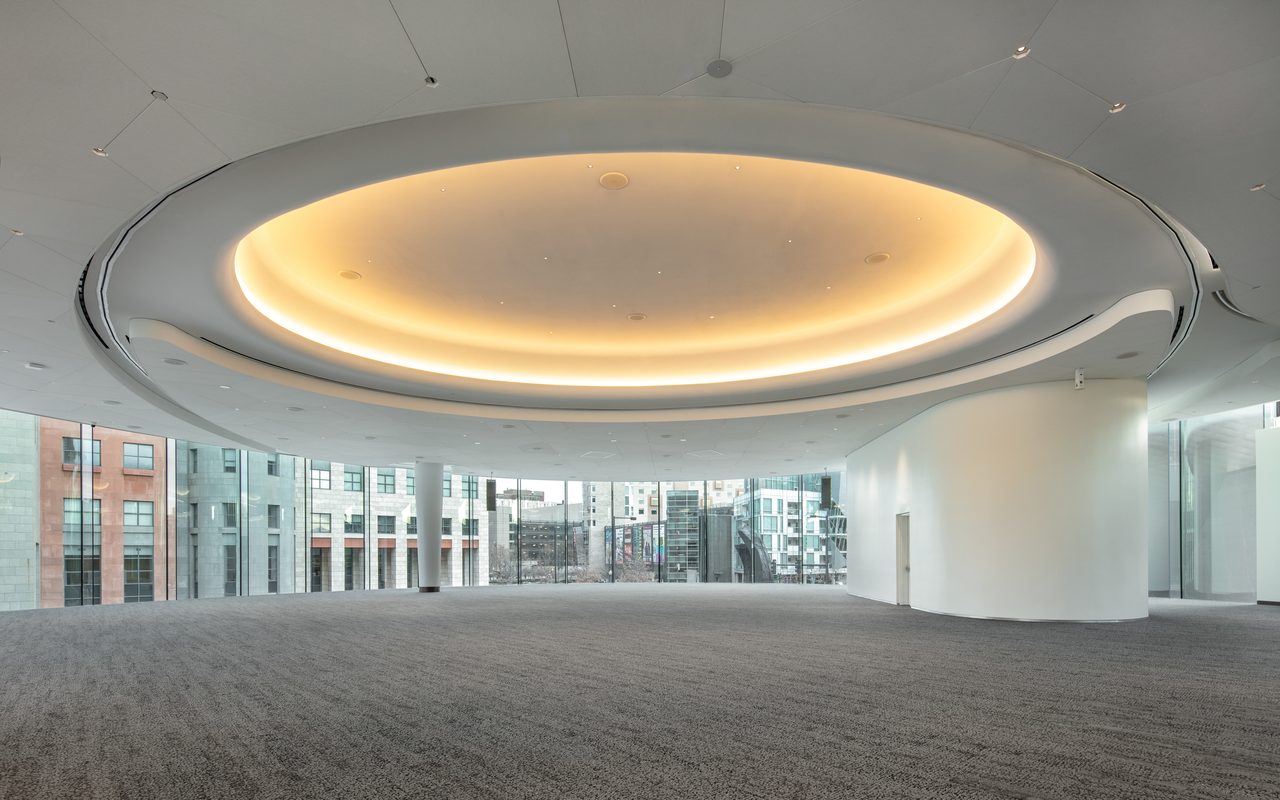
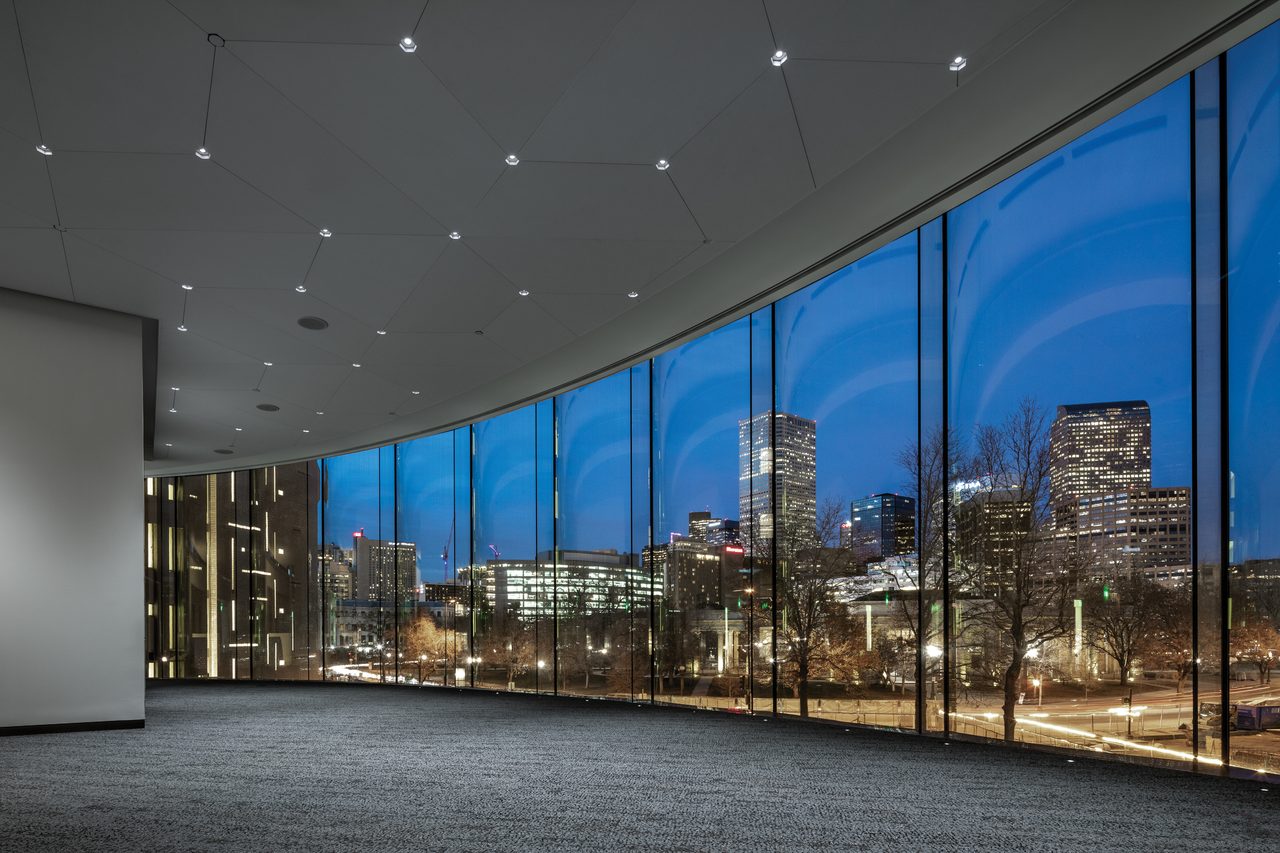
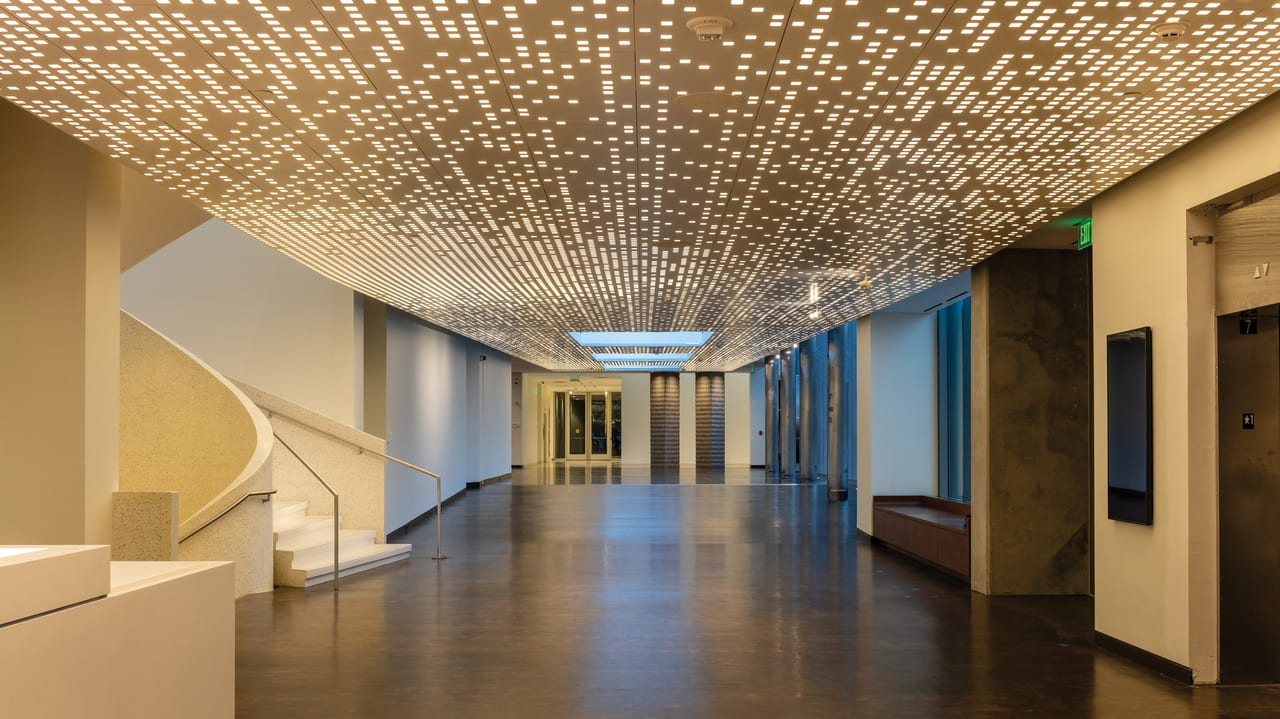
Design for Art’s Sake
Two custom ceilings helped rejuvenate the time-honored design of an Italian architect while enhancing the Denver Art Museum experience with modern upgrades.
By Robert Marshall
Renovating and expanding a world-renowned art museum designed by a well-known Italian architect comes with its share of design challenges. But for the Denver Art Museum, an iconic institution of visual art, it was a necessary revitalization effort to better serve the steady increase in foot traffic that has now grown to more than 800,000 annual visitors.
One of the more iconic structures that grew from the museum’s late 20th century expansion is the Martin Building. Formerly known as the North Building, it is a dramatic two-towered, eight-story, castle-like gallery designed by Italian modernist Gio Ponti and completed in 1971. The design was a sharp departure from the temple style often associated with gallery architecture.
“If a museum has to protect works of art,” Ponti once famously noted, “isn’t it only right that it should be a castle?”
As part of a larger campus renovation, the museum’s leadership announced plans in 2016 for a significant overhaul of the Martin Building to keep pace with the increasing patronage. The goals were straightforward: modernize the building to meet the demands of today’s museum-goers; align it visually and functionally with its campus neighbors, the Hamilton Building and the Denver Central Library; and preserve the integrity of Ponti’s original creative vision. Transforming those goals into a reality, however, was no small feat.
“Our mantra for the revitalization effort was always, ‘What would Ponti do?’” says Stephanie Randazzo Dwyer, principal at Boston’s Machado Silvetti, who, along with Denver’s Fentress Architects, served as the architectural team behind the renovation. “At Denver Art Museum, Ponti employed unusual and incredibly striking combinations of triangular shapes and curved shapes in everything from the exterior form of the building to a one-of-a-kind stainless steel entrance portal, to huge elliptical scoops cut out of the top of the building. Our vision was to hew as close as possible to all of Ponti’s details, while upgrading technical systems, increasing vertical transportation capacity, upgrading the weather envelope, and ensuring accessibility throughout the building.”
All improvements were designed to heighten the gallery’s offerings and enhance the visitor experience. This included the addition of the new Anna and John J. Sie Welcome Center, an elliptical structure with a glass facade housing guest services, two dining options, a special corridor, and a second-level event space that expands the museum’s functional versatility.
While the welcome center enjoys an abundance of natural light, the design also called for the clever use of interior artificial light to add to the visitor experience. One of Ponti’s central themes was light play: “I asked the sun and the light and the sky to help me,” Ponti quipped of his design. More than a million reflective glass tiles cast light patterns across the exterior of the castle’s towers, while the seemingly randomized fenestration mixes various window shapes and sizes into positions that add to the light play inside, and strategically protect artwork from the deleterious effects of sunlight.
Manipulating the welcome center’s artificial light with the same playfulness required similar innovation and artistry to that which Ponti had employed—plus the right materials to execute it. That’s where two custom-engineered, awe-inspiring ceilings come in.

Creating Light from Above
A vast, glass-clad corridor connects the Welcome Center to the Martin Building’s gallery halls, offering a panoramic view of the castle’s northern tower. Designers from Machado Silvetti and Fentress Architects used the ceiling in this space as a creative canvas for light play.
By applying the look of Ponti’s fenestration to the corridor’s ceiling, the design team created an orderly but randomized pattern of squares of artificial light that shine through the plenum, coupled with massive rectangular skylights in an echo of the tiles and windows on the tower’s exterior. The effect provides downward illumination while drawing the eye upward to the magnificent skylights framing the tower in picturesque form.
“We designed the ceiling as a perforated surface with an integrated lighting system,” says Randazzo Dwyer. “The perforations in the surface essentially allow light to pass through the ceiling from a grid of LED lights above.
Because traditional ceiling products were insufficient for an installation of this scope, CertainTeed Architectural was tapped to custom engineer an entirely new configuration of lighting integration with fire-rated medium density fiberboard.
The first challenge was finding a structured core material for the ceiling panels that would provide the level of acoustical comfort required for a museum while allowing light transmission from behind the panel. Fully engineered MDF lay-in panels were ultimately selected and perforated with hundreds of crisp, cleanly finished square holes to create the randomized pattern.
“The perforations are located all across the Main Hall ceiling, but the holes are denser at important areas, such as the door to the restaurant or the elevator to the Event Space, says Randazzo-Dwyer. “When the holes are denser, the light is brighter and thus the visual effect is like clouds of light marking points of interest—a sort of subtle overhead way-finding.”
The perforated panels were backed with the translucent acoustical light-diffusing fabric to allow the light from fixtures within the plenum to emanate.
To prevent unwanted light from leaking through spaces between the panels, they were suspended from a lay-in lift and shift suspension system and coupled with specially crafted splines to provide near seamless joints that seal the system.
The result is a spectacular array of lights that is both visually stunning and functionally practical, providing light, delight, and acoustical performance for this busy throughway.
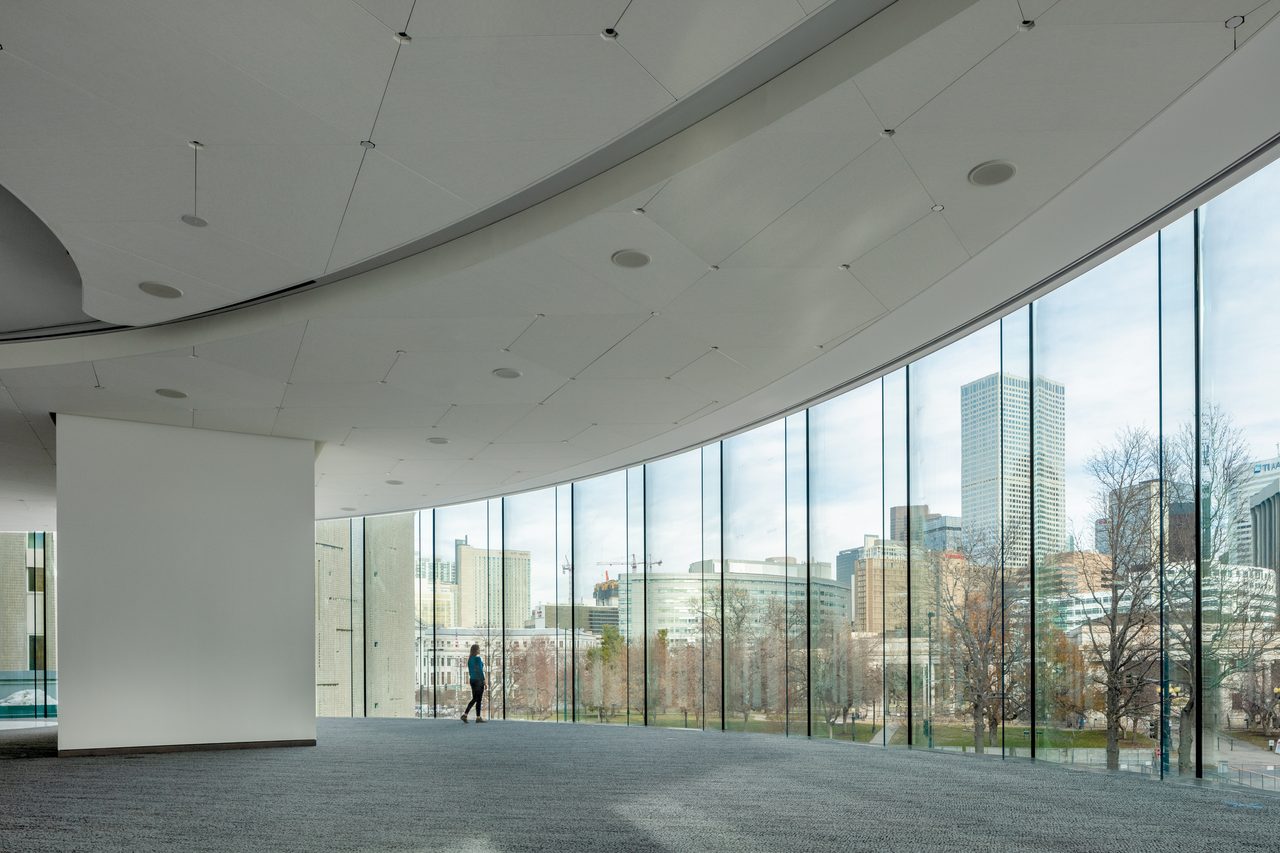
Expanding Functionality
The ceiling design ingenuity carries through to the Welcome Center’s second-floor events space.
With the center’s elliptical profile, the Events Space ceiling needed to maintain a fluid shape while providing excellent acoustics to suit large gatherings. The design team relied on another high-performance and design-forward product: Decoustics Claro, a malleable ceiling product that resembles plaster but offers superb sound absorption.
The material was custom engineered into trapezoidal shapes that were pieced together in a puzzle fashion, with recessed lighting at every adjoining corner. The combined tiles suit the structure’s unique elliptical shape, culminating in a large recessed circular section at the space’s core, complete with a halo of artificial light.
“The ceiling for this kind of designed flexibility is a major technical and aesthetic challenge,” says Randazzo Dwyer. “It had to meet the technical needs of many different room configurations for gatherings, each with their own unique requirements for air handling, rigging, lighting, audio, and visual systems.”
The panels were placed in a customized concealed aluminum suspension system that features a unique torsion spring mechanism to facilitate panel placement, enabling a swifter installation and full downward accessibility for maintenance and repairs. Special butterfly clips secure various fixtures within the plenum to prevent them from being entangled in the hanger wires and rods that suspend the grid, all while providing a monolithic visual on the ceiling surface below.
“Besides what the ceiling looks like for those inside, the all-glass walls mean that the Event Space ceiling is seen by everyone who is outside,” explains Randazzo Dwyer. “It had to be functional and iconic for both the interior and exterior.”
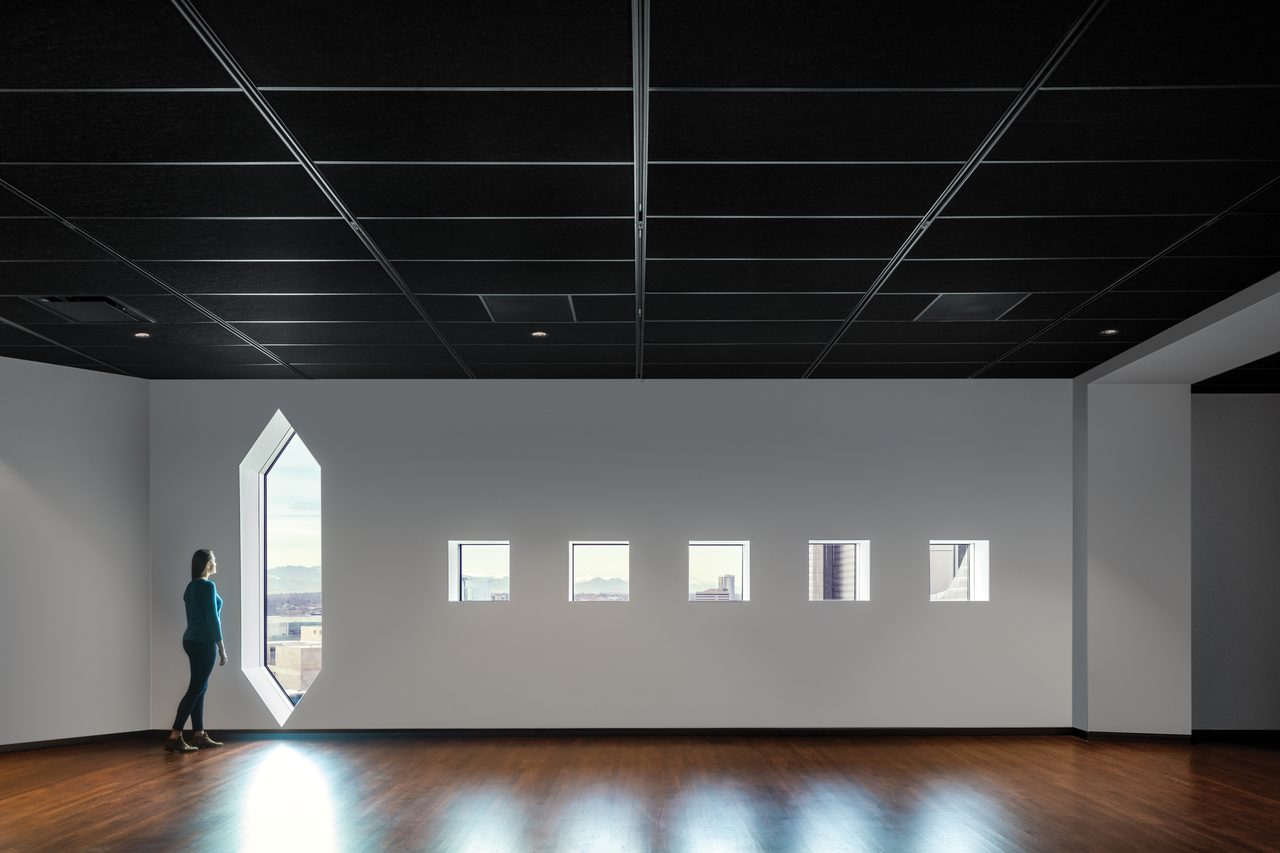
All About the Art
In the main castle section of the Martin Building, the gallery spaces serve a singular purpose: highlighting and celebrating a world-renowned art collection.
The intent for the ceilings in the galleries was that they should recede and contribute to a sense of calm. With their matte, non-reflective black surface and exceptional acoustical control, Theatre Black f acoustical panels—paired with a coordinating black suspension system—provide a sleek, modern look while contributing to the peaceful gallery ambiance.
A Resounding Result
After more than a year of planning, testing, creating mock-ups, and developing design solutions, the resulting ceilings in all areas of the museum are works of art in their own right—true testaments of design ingenuity paired with creative installation.
“We began working with the manufacturer early in the design process and brought to the table many layers of challenges with regards to maintenance, accessibility and the complex integration of lighting.” says Randazzo Dwyer. “And each step of the way their team of engineers had helpful suggestions. The ceilings manufacturer was right for this project because they have a great combination of technical knowledge and design innovation in order to achieve custom elegant solutions to acoustical and accessible ceilings.”
All Images Credit: CertainTeed Architectural.
Robert Marshall is a senior technical manager for CertainTeed Architectural and a 45-year participant in the commercial ceiling industry.
